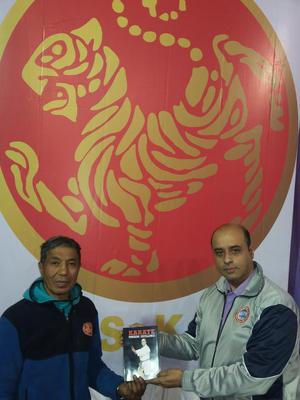Interview - Pemba Tamang Shihan - 8th Dan
by Arijit Chakraborty
(Kolkata, India)

Pemba Tamang Shihan and Arijit Chakraborty
This interview with Shihan Pemba Tamang, 8th Dan, Chief Instructor of Nihon Shotokan Karate Federation (NSKF) one of the first non-Japanese instructors to complete the JKA Instructor Course, tells the story of his struggles and pursuits for Budo Karate.
Six years after arriving in Japan, studying under the likes of Senseis Asai, Osaka and Yahara, he enrolled in the JKA Kenshusei. He remembers about the experiences of being taught by such a ‘powerhouse of teachers’. Pemba Shihan is also the author of the bestselling book “Finding the Way”. This interview was conducted by Arijit Chakraborty 5th Dan, a disciple of Pemba Tamang Shihan and National Special Correspondent of the World of Martial Arts, Mumbai, in January 2016 at Darjeeling, on the sidelines of the NSKF South Asian Karate Camp & Championships.
(Arijit Chakraborty) Sensei, please tell us how you were first introduced to the Martial Arts and what was it about karate that initially drew you?
(Pemba Tamang) When I was young, I simply wished to be a strong man and joined a Karate club near my home in Darjeeling when I was ten years old. I practised hard and thought that I was learning ‘real karate’.
(AC) Sensei, what drew you to Japan to train?
(PT) After about 8 years at the club, I became the best fighter, and in my small town, everyone respected me for this. However, I realised that the Karate we were learning wasn’t the real ‘way,’ and felt insecure and not true to myself for gaining admiration from all the towns people, but not really practicing true Karate. So I decided to learn ‘real’ Karate in Japan and flew to Japan when I was 19 years old.
(AC) Sensei, who did you train under at JKA?
(PT) It was a rotation of several high-profile instructors such as Asai, Abe, Ueki, Tanaka, Osaka, Yahara, as well as other JKA instructors. In retrospect, I was so lucky to be taught by such a powerhouse of teachers. But the influence of Tanaka Sensei, Yahara Sensei and Asai Sensei is just unforgettable.
(AC) Sensei would you please give us an idea of the type of classes you experienced?
(PT) Training was deeper, harder and more detailed. Each technique was broken down for us to understand, and we were physically conditioned so our bodies were able to do what we were being taught. Repetition was taken to extreme; in normal classes we would do 20 but in the kenshusei it would be something like 200.
Emphasis was also placed on studying techniques in a more academic way, to understand the theory behind the action. Kumite was particularly tough, I felt like a “sandbag” and I was blooded almost every day. This was done to highlight our weaknesses in kumite, but also to build our spirit and accept the emotions that are associated with fear.
(AC) Sensei, what were the most important things you took away from the instructors class?
(PT) In the Instructor’s classes we worked very hard as a group, to build a high standard with our karate techniques. We were able to see top sensei using their techniques at the highest level of perfection. It was for us to try and imitate their amazing skills, but of course this is not easy. Working together, our goal was to achieve a high standard across all techniques, but as we began to reach this, we were then encouraged to specialise in one or two techniques that would maybe one day become our own trademark techniques.
(AC) Sensei, what is your favourite kata and why? And what is your favourite technique?
(PT) My favourite kata is Bassai dai and Heian shodan. Heian shodan is very simple, Bassai dai is very strong and focuses on hip movement. My favourite techniques are gyaku zuki and mae geri, two simple but explosive techniques.
(AC) Sensei, your book “Finding the Way” is a big hit globally. What is your message through this excellent book?
(PT) I was like a baby when I first came to Japan, so today, after 26 years I have become a man. It’s a long journey. Karate is about lifelong effort and having a strong character, that is my message through the book. Also, I urge karate-ka around the world to follow the Dojo Kun in their daily lives. My life, my story in the book should enable others to find their ‘way’.
(AC) Sensei, how is NSKF doing and how has the response been from different countries?
(PT) NSKF is a young organisation and has more than 25 countries as part of the family. NSKF India is growing with more states joining us. Our presence in Russia, Europe and US is growing fast. This year, I am conducting seminars in London, Paris and other parts of Europe.
(AC) Sensei, a huge thank you for this opportunity to interview you and may I wish you and your organisation NSKF, every success for the future. I am glad to have been your disciple for the past 20 years and look forward to learning and training under you in the future. Oss, Arigato Gozaimashita.
(PT) You are very welcome. Thanks Arijit for coming here from Kolkata to meet me and please feel free to visit my dojo in the beautiful mountains of Kobuchizawa. Oss.